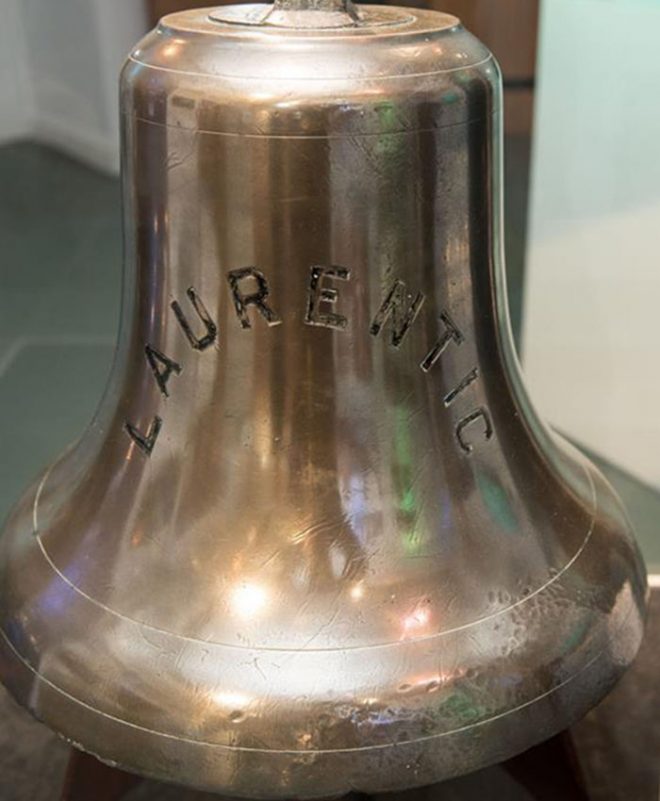
The bell from the SS Laurentic going on display at Harland & Wolff in Belfast
IT’S one of the most iconic artefacts in Derry’s maritime history and this week the Laurentic Bell is on its travels once again, this time journeying back to its White Star roots, where it has gone on temporary display at the Titanic Hotel in Belfast.
The bell was recently acquired at auction by Derry City and Strabane District Council and has been on show in the Guildhall, as one of the most famous pieces of salvage to be found in local waters.
The SS Laurentic was completed by Harland and Wolff in 1908, and just a few months later the same shipyard workers began work on the ship’s more famous cousin Titanic.
The Titanic Hotel now occupies the former Harland and Wolff Headquarters which has been refurbished by Harcourt Developments as a celebration of the local ship building industry and its prominent role in the history of Belfast.
The bell has been put on display at the entrance of the hotel where visitors can read about the White Star stories which link the two cities.
While of course the Titanic’s tragic history is known the world over, the Laurentic’s similarly terrible fate is perhaps less well known beyond Irish shores. But last year the spotlight returned to the fascinating story as the city’s Mayor hosted a special event marking the centenary of its sinking.
More than 350 people died of exposure as the Laurentic sank in the freezing waters of the Swilly after it was destroyed by a mine just an hour after it departed Buncrana on January 25, 1917. The crew desperately rang the ship’s bell with a wrench to call for help denting the surface as it sank.
Curator with Derry City and Strabane District Council’s Museum and Visitor Service, Roisin Doherty, said the return visit to Belfast was another chapter in the historic bell’s dramatic story.
“The Laurentic Bell is such an emotive symbol of the North West’s maritime history. We are delighted to have acquired it after all these years since it was salvaged it from the wreck.
“The story of the Laurentic is a fascinating one – and the fact that the ship was secretly transporting around £300m of gold bullion on board adds to the mystique of the unfortunate vessel. Despite the ongoing efforts of local divers to salvage the last of its hoard, it’s thought that 22 gold bars still lie on the seabed to this day.
“We are delighted to bring the bell to Belfast where the Laurentic was a proud member of the White Star fleet. I hope we can continue to work together to promote the shared maritime history of our two cities.”
Creative Director at Harcourt Developments, John Doherty, said, he was delighted to welcome the bell on its journey to the building where the ship was designed.
“We are very proud to be displaying SS Laurentic ship’s bell at Titanic Hotel Belfast.
“To have the symbolic heart of the ship – its engraved bell – come back home after 110 years and be on public display in the very same building where the beautiful liner was originally designed by Harland & Wolff, is such a powerful and significant moment.
“The entire White Star Line fleet was designed in this building and constructed on the slipways outside so to be able to display the bell today is a great honour.
“We would like to thank the Derry City and Strabane District Council, the owners of the bell, for generously lending this historic maritime artefact and we invite everyone to visit the hotel to see the exhibit for themselves.”
The SS Laurentic was originally a passenger cruise ship with the capacity to carry 230 First Class passengers, 430 Second Class and 1000 Third Class passengers and a crew compliment of 387, when World War I broke out the Laurentic was immediately requisitioned by the Admiralty for war duty, as a troop ship.
After being refit in 1915 as an armed merchant cruiser she made her final tragic voyage on her way to Nova Scotia.
The bell was eventually recovered in 1979 by local diver Ray Cossum and his son Des with Allerton Salvage.
It weighs 37kg and is 2ft high by 2ft wide at the base.
The bell will remain on display at the Titanic Hotel Belfast until the end of July when it will return to the Guildhall, before eventually becoming part of the collection to be housed in the new Maritime Museum planned for the city.
Tags:




